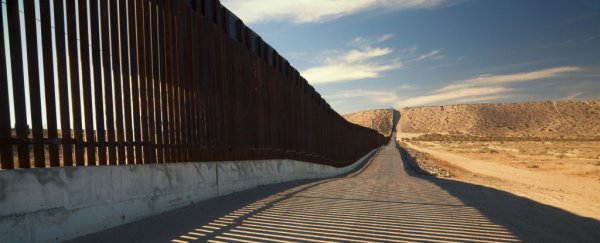Thousands of scientists expressed alarm this week at the expansion of the wall on the U.S.-Mexico border.
A report in BioScience outlined the dangers of building a continuous and impermeable border wall, saying it would harm animals and plants in this sensitive region. The scientists cite bypassed environmental laws, habitat destruction, and losses to conservation and scientific research as the primary areas of concern.
The region is home to more than 1,500 native plant and animal species, including several endangered species. After posting the article, lead author Robert Peters of Defenders of Wildlife, a conservation advocacy group, put out a call for scientists to sign on to it.
The report has 16 co-authors, including eminent scientists such as E.O. Wilson and Paul Ehrlich, and as of Tuesday has 2,700 signatures from almost 50 countries.
The border wall's construction and enforcement affects more than just the narrow strip around a physical wall. It also includes roads and access on both sides, as well as off-roading patrols, said Jennifer Miller, co-author and senior scientist at Defenders of Wildlife.
"This would be the only wall on earth that would split a continent," Miller said.
"We should be concerned about conserving biodiversity because ecosystems can become unraveled when we don't," said William Ripple, an ecologist at Oregon State University and an author on the paper.
"And when ecosystems become unraveled, it doesn't bode well for humans."
For example, said Gerardo Ceballos, an author on the report and an ecology professor in Mexico City, changing ecological landscapes can affect the quantity and quality of available water.
"When you lose them [animals and plants], you're losing the capabilities of the environment to provide the conditions we need to have a good life," he said. The border wall would be a "massive blow" to the ecosystem and "truly affect the human communities," Ceballos said.
American bison, a wildlife icon, now has populations at the border. Krista Schlyer, a photographer and filmmaker working on a documentary about border wildlife, remembered the moment she realized the importance of the border lands habitat. She watched a small group of bison hop over a broken-down barbed-wire fence.
Interviews with ranchers on both sides of the border revealed that the bison were using the American side for feeding on a kind of nutritious grass and the Mexican side for drinking from a pond, one of the only water sources.
"One of the big misconceptions is that people sort of think of it as a desert. Which it is, it's a desert, but it's an extremely biodiverse desert ecosystem," said Schlyer on a phone call from Mission, Tex., at the border.
The landscape is dotted with hunched mesquite trees. Butterflies of "every color" float by on the hot breeze, she said.
The House Appropriations Committee is discussing a homeland-security spending bill that allocates a suggested $5 billion for the border wall and associated security.
"What I'm hoping is that our national leaders and administration and congressional leaders will notice our report and listen to the concerns we have," said Ripple.
Historically, border walls are known to be bad for wildlife. However, this report also details the negative impacts it could have on scientists and international collaboration.
In Organ Pipe Cactus National Monument in Arizona, "a rookie Border Patrol employee held us at gunpoint on our stomachs for one and a half hours, threatening to shoot us if we moved," said Gary Nabhan, an ecologist, in an interview with Peters recorded in an earlier report.
"He was unaware that there is significant research being conducted at this National Park site along the border."
2018 © The Washington Post
This article was originally published by The Washington Post.
Science AF is ScienceAlert's new editorial section where we explore society's most complex problems using science, sanity and humor.
